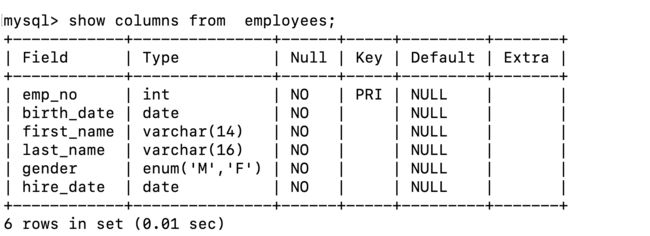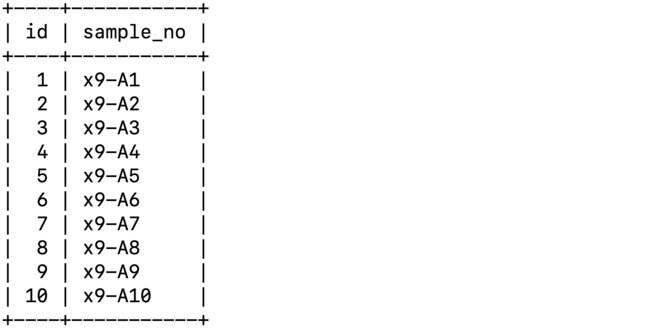Django model high find(Django模型高级查询)
Django model high find
Model
class Employees(models.Model):
emp_no = models.IntegerField(primary_key=True)
birth_date = models.DateField()
first_name = models.CharField(max_length=14)
last_name = models.CharField(max_length=16)
gender = models.CharField(max_length=1)
hire_date = models.DateField()
class Meta:
managed = False
db_table = 'employees'
View
group_by
**importance ** if you want to group in Django, You must use annotate with order_by and values。
重要,如果你想在Django进行分组,你必须annotate和order_by同时使用。
Employees.objects.values('birth_date').annotate(count_birth=Count('birth_date')).order_by('birth_date').all()
generate sql
SELECT `employees`.`birth_date`, COUNT(`employees`.`birth_date`) AS `count_birth` FROM `employees` GROUP BY `employees`.`birth_date` ORDER BY `employees`.`birth_date` ASC
order_by
if you want to order_by in django. You can use order_by.
employs = Employees.objects.order_by('birth_date').all()
generate sql
SELECT `employees`.`emp_no`, `employees`.`birth_date`, `employees`.`first_name`, `employees`.`last_name`, `employees`.`gender`, `employees`.`hire_date` FROM `employees` ORDER BY `employees`.`birth_date` ASC
indicates to query certain fields(只查询某些字段)
if you query all the fields。this is a time-consuming operation. (如果你想查询所有的字段,这是一个耗时的操作)
so we need fields queries. 所以我们需要指定字段查询
values
employs = Employees.objects.values('birth_date').all()
generate sql
SELECT `employees`.`birth_date` FROM `employees`
use mysql fun
if we want to use Count, Max, or Sum and some other func。we can importing Django‘s build-in methods.
如果你想使用count,Max或者sum等其他一些函数,我们可以导入Django的一些内置方法。
count
from django.db.models import Max, Count
Employees.objects.values('birth_date').annotate(count_birth=Count('birth_date')).order_by('birth_date').all()
Generate sql
select `employees`.`birth_date`, COUNT(`employees`.`birth_date`) AS `count_birth` FROM `employees` GROUP BY `employees`.`birth_date` ORDER BY `employees`.`birth_date` ASC
use aggregate func
Django provides two aggregate function。annotate and aggregate。
annotate
Annotate allow you to alias fields and use aggreate func
example
Employees.objects.values('emp_no', ).annotate(name=F('emp_no')).all()
generate_sql
SELECT `employees`.`emp_no`, `employees`.`birth_date`, `employees`.`first_name`, `employees`.`last_name`, `employees`.`gender`, `employees`.`hire_date`, `employees`.`emp_no` AS `name` FROM `employees` LIMIT 10'
aggregate
**aggregate return a dict not a queryset ** aggregate also always the fields to to aliasd
aggratale 返回的是一个字典,并不是一个queryset。他也支持给字段取别名
Employees.objects.aaggregate(Max('birth_date'))
return result
{'birth_date__max': datetime.date(1965, 2, 1)}
complex query(复杂查找)
here’s some data。I wish to cut useing - sample, and then sort the front fields and the last fields.
这有一些数据,我希望使用-对sample进行切割,然后使用前面的字段和后面的字段进行排序。
example
sample_detail = SampleDetail.objects.values('sample_no', ).annotate(
first_field=Left('sample_no', StrIndex('sample_no', Value('-')) - 1),
last_field=Right('sample_no', StrIndex('sample_no', Value('-')) - 1)
).order_by('first_field', 'last_field').all()
generage_sql
SELECT `sample_detail`.`sample_no`, LEFT(`sample_detail`.`sample_no`, (INSTR(`sample_detail`.`sample_no`, -) - 1)) AS `first_field`, RIGHT(`sample_detail`.`sample_no`, (INSTR(`sample_detail`.`sample_no`, -) - 1)) AS `last_field` FROM `sample_detail` ORDER BY `first_field` ASC, `last_field` ASC

